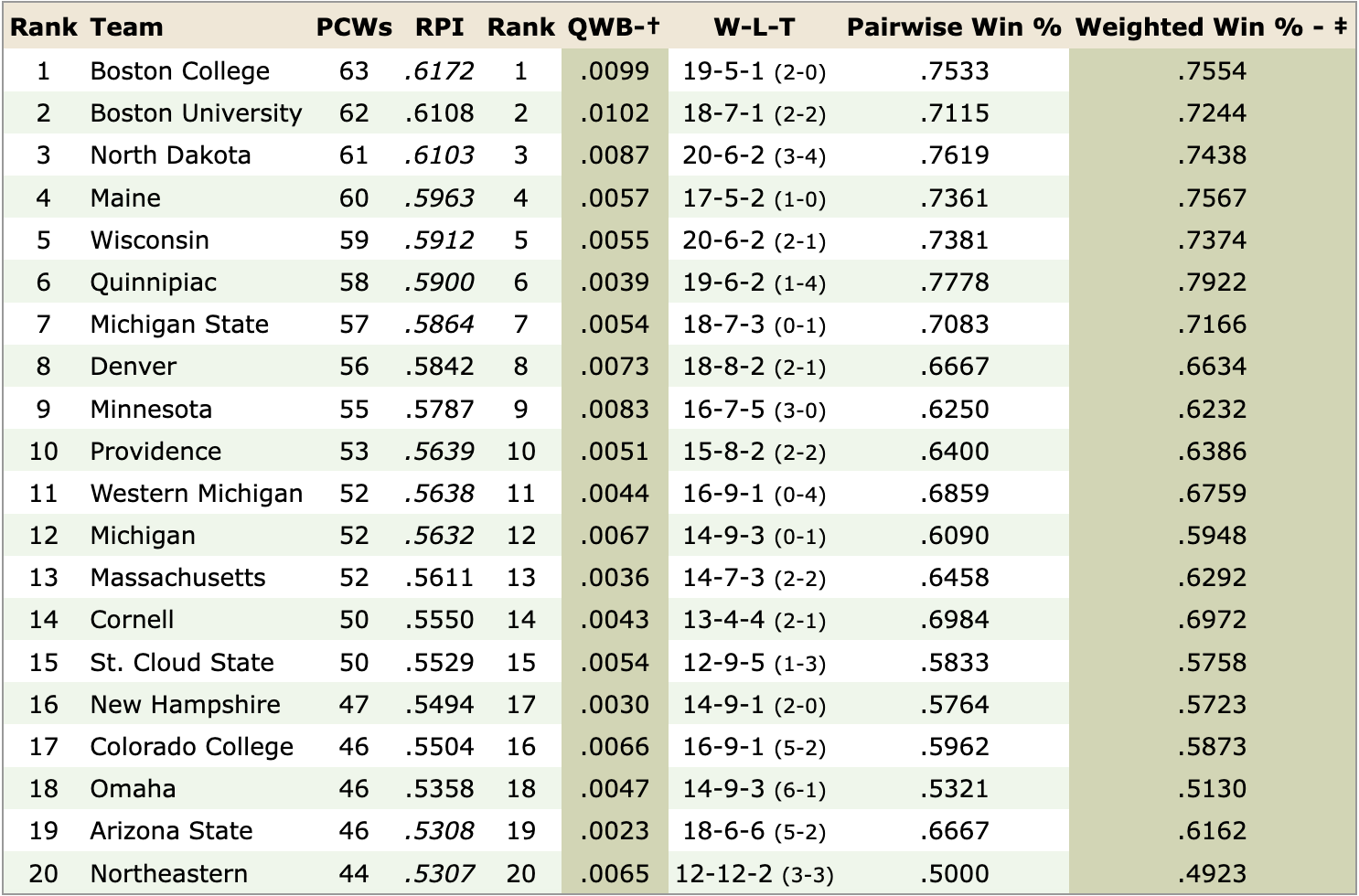ECH "Bracketology": Version 4.0
WRITTEN BY ALEX BERGER - February 8th, 2024If you read last week's article you would've seen me use the phrase "...we have never had a 'Bracketology' fall into place as well as this one has." I should've kept my mouth shut. Now, arguably, we have to put together one of the most difficult versions of the year.
Although the rankings are fairly straightforward, there are two key questions the NCAA Tournament selection committee will need to ask as they focus on bracket fairness vs. attendance. A big key to that has to do with one of the two regional hosts in the mix to make the last 16 this season.
- How The NCAA Tournament Field Is Determined
16 teams qualify for the NCAA tournament every year. Automatic bids are given to the conference postseason champions, and the other "at large" bids are calculated through the Pairwise. That is, long-story short, a mathematical system that ranks teams based on their record, their opponent's record, and their opponent's opponent's records.
This year, the four regional sites (teams hosting) are in Maryland Heights, Missouri (Lindenwood), Providence, Rhode Island (Brown), Sioux Falls, South Dakota (Omaha), and Springfield, Massachusetts (UMass). If any of the hosting teams qualify for the tournament, they will be automatically placed at their regional site. The four regional winners go to the Frozen Four, which is in St. Paul, Minnesota this year.
In the past, the NCAA tournament selection committee has placed teams at certain regional sites in order to increase attendance. However they also have to balance this with keeping bracket integrity as much as possible (i.e. #1 seed plays #16, #2 plays #15, etc.). Conference matchups are also avoided in the first round of the tournament, which causes matchups to occasionally flip.
Teams have to have a .500 or better record in at least 20 games against Division 1 opponents to be eligible for an at-large bid.
- The Current Field
So, let's start looking at who would be in the tournament if the season ended today. We're taking rankings based on Thursday, February 8th. Although anything can happen in the postseason, to make it easier we will use who is currently leading their respective conferences as champions.
Automatic Bids: RIT (Atlantic Hockey, #22 in Pairwise), Michigan State (Big Ten, #7), Minnesota State*** (CCHA, #29), Quinnipiac (ECAC, #6), Boston University (Hockey East, #2), and North Dakota (NCHC, #3).
***: St. Thomas is currently first in the CCHA, but is ineligible for the NCAA Tournament in '23-'24. Minnesota State is awarded the automatic bid.
Six teams earn automatic bids, which means the next ten highest ranked teams in the Pairwise earn "at-large" bids. Here is the current top-20 in the Pairwise, credit to College Hockey News.
"At-Large" Bids: Boston College, Maine, Wisconsin, Denver, Minnesota, Providence, Western Michigan, Michigan, Massachusetts, and Cornell
We've got our 16 teams. As it stands, the first four teams out would be St. Cloud State, New Hampshire, Colorado College, and Omaha
- Putting Together The Regionals
Now we can start ranking the 16 qualifying teams by seeds using the Pairwise rankings. The top four teams are #1 seeds, next four are #2 seeds, and so on.
#1 Seeds (1-4): Boston College (#1), Boston University (#2), North Dakota (#3), and Maine (#4).
#2 Seeds (5-8): Wisconsin (#5), Quinnipiac (#6), Michigan State (#7), and Denver (#8).
#3 Seeds (9-12): Minnesota (#9), Providence (#10), Western Michigan (#11), and Michigan (#12).
#4 Seeds (13-16): Massachusetts (#13), Cornell (#14), RIT (#15), and Minnesota State (#16)
Next step, matching up teams to keep tournament integrity. We've got eight games in the first round, placed in four different regionals:
Regional 1: #1 Boston College vs. #16 Minnesota State, #8 Denver vs. #9 Minnesota.
Regional 2: #2 Boston University vs. #15 RIT, #7 Michigan State vs. #10 Providence.
Regional 3: #3 North Dakota vs. #14 Cornell, #6 Quinnipiac vs. #11 Western Michigan.
Regional 4: #4 Maine vs. #13 Massachusetts, #5 Wisconsin vs. #12 Michigan.
We've got two conference matchups in this iteration, both in regional four. To solve the issue of #4/#13 North Dakota draws the short straw as the only non-Hockey East one seed. They'll head east to face Massachusetts at their hosted regional, taking the Fighting Hawks away from Sioux Falls and taking a east regional away from a top seed. It's easier to solve #5/#12, as we'll just swap Western Michigan and Michigan.
Regional 1: #1 Boston College vs. #16 Minnesota State, #8 Denver vs. #9 Minnesota.
Regional 2: #2 Boston University vs. #15 RIT, #7 Michigan State vs. #10 Providence.
Regional 3: #3 North Dakota vs. #13 Massachusetts, #6 Quinnipiac vs. #12 Michigan.
Regional 4: #4 Maine vs. #14 Cornell, #5 Wisconsin vs. #11 Western Michigan.
When determining regional sites, the committee (usually) recognizes that driving is easier for teams and fans. However, once flying has been determined, it doesn't necessarily matter where that team is flying to. There are two east regionals (Providence, Springfield) and two west regionals (Maryland Heights, Sioux Falls) this year.
As mentioned above, Massachusetts gets placed in Springfield, MA as the regional host along with North Dakota. Then, despite three teams from the west, we'll award #1 Boston College the Providence regional. That's the advantage you get as the top team in the country. There really isn't a great option for the last two regionals, so we'll place Maine's in Maryland Heights as it's closer for the next top two seeds Wisconsin and Western Michigan. That leaves the Sioux Falls regional for #2 Boston University.
- Final Result
Providence, RI: #1 Boston College vs. #16 Minnesota State, #8 Denver vs. #9 Minnesota.
Sioux Falls, SD: #2 Boston University vs. #15 RIT, #7 Michigan State vs. #10 Providence.
Springfield, MA: #3 North Dakota vs. #13 Massachusetts, #6 Quinnipiac vs. #12 Michigan.
Maryland Heights, MO: #4 Maine vs. #14 Cornell, #5 Wisconsin vs. #11 Western Michigan.
It's a good thing that the committee chooses the eventual bracket, as there are a lot of difficult decisions to make in 'Version 4.0.' For example, is it worth it to swap teams of different seeds to fix conference matchups? Earlier we could've switched #12 Michigan and #13 Cornell to fix both, while keeping North Dakota out west and Maine out east. Then later, the question of should the #1 overall seed get the huge advantage of the nearest regional remaining? If we chose to send Boston College out west to Sioux Falls we would've arguably given the Eagles a tougher regional to play in, but solved the attendance issue there (Denver, Minnesota, and Minnesota State are in BC's regional).
Either way, the committee has to be cheering for Massachusetts to either move up or down (no offense UMass fans) in the Pairwise. As a four seed there is so much less flexibility when it comes to matchups, as three of the five teams from Hockey East in this week's bracket are #1 seeds.
Make sure to let us know what you would do differently! There are a lot of different ways that this version could be arranged. As a fan of your team, of course you want the rules to be bent in favor to keep them closer to home, but the committee has set these rules in place over the last 10-20 years to try and keep it fair for everyone involved. However, with a recent focal point on attendance, this year may be one to try something differently.


